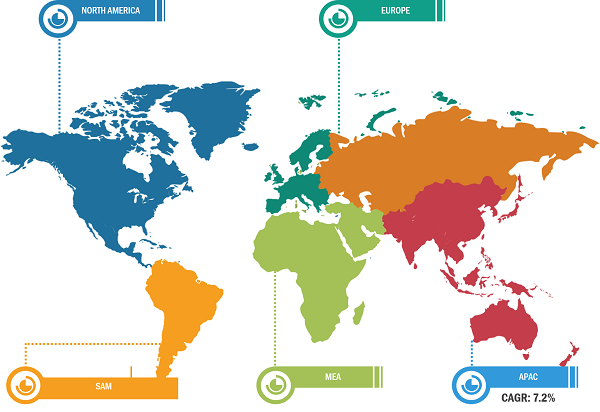Increase in Number of Industrial Accidents to Drive Workwear Market
According to our latest market study on “Workwear Market Forecast to 2030 – Global and Regional Share, Trend, and Growth Opportunity Analysis – by Product Type, Category, Distribution Channel, End Use, and geography,” the workwear market size is projected to grow from US$ 32,078.76 million in 2022 to US$ 52,448.15 million by 2030; the market is expected to record a CAGR of 6.3% from 2022 to 2030. The report highlights key factors driving the market and prominent players along with their developments in the market.
Industrial accidents are one of the major concerns across various industrial sectors. These accidents have severe consequences on human health. There have been numerous cases of accidents at work globally in various industries, such as construction, oil & gas, and mining. According to the International Labour Organization (ILO), approximately 2.78 million work-related deaths are recorded yearly, of which 2.4 million are related to occupational diseases. Additionally, there are ~340 million occupational accidents and 160 million victims of work-related illness annually across the world.
Workwear Market Breakdown – by Region
Workwear Market Size and Forecasts (2020 - 2030), Global and Regional Share, Trends, and Growth Opportunity Analysis Report Coverage: By Product Type (Topwear, Bottomwear, and Coveralls); Category (Men, Women, and Unisex); Distribution Channel (Wholesalers, Supermarkets and Hypermarkets, Specialty Stores, and Online Platforms), End Use (Construction, Oil and Gas, Chemicals, Healthcare, and Others), and Geography
Workwear Market Size, Share, Growth & Scope | Analysis 2030
Download Free Sample
Further, International Labour Organization (ILO) stated that work-related diseases caused the most deaths among workers. Hazardous substances alone are estimated to cause 651,279 deaths a year. Various industries, such as construction, mining, oil & gas, automotive, and healthcare, record numerous work-related deaths and injuries every year. The construction industry has a disproportionately high rate of recorded accidents. According to the International Journal for Research in Applied Science & Engineering Technology, construction-related deaths accounted for around 18.17% of fatalities across the US from 2009 to 2018. The rising rate of accidents at work has shifted the focus toward employee safety, which is increasing the demand for industrial workwear.
Key players operating in the global workwear market include Carhartt, Inc.; Aramark; Alisco Group; Alexandra; 3M; A. LAFONT SAS; Fristads Kansas Group; Hultafors Group; and Lakeland Industries, Inc. These companies have a widespread global presence, which allows them to serve a large set of customers from all over the world and subsequently increases their market share They heavily focus on new products launch and geographical expansion to expand their product range in specialty portfolios.
Impact of COVID-19 Pandemic on Workwear Market
The COVID-19 pandemic brought unprecedented challenges for many industries, including construction, oil & gas, chemicals, and mining. Lockdowns, border restrictions, travel bans, plant shutdowns, and other government-led safety protocols disturbed the operations of manufacturing companies. The COVID-19 pandemic also created a shortfall in production due to the shortage of raw materials and labor, which hampered the market shares of small-scale and large-scale workwear manufacturers across different geographies. However, the demand for workwear increased due to its rising usage in the healthcare sector to ensure the safety of healthcare workers.
The COVID-19 pandemic led to the rise in demand for healthcare PPE to protect healthcare personnel involved in the treatment of COVID-19 patients, and this subsequently drove the healthcare workwear market globally. The outbreak across developed and developing countries created a significant demand for healthcare PPE products, such as gloves, gowns, coveralls, face shields, masks, and goggles. Companies operating in various sectors paused production and converted their facilities to produce healthcare workwear, such as masks, gowns, and PPE kits.
The report includes the segmentation of the workwear market as follows:
Based on product type, the workwear market is segmented into topwear, bottomwear, and coveralls. Based on category, the market is segmented into men, women, and unisex. Based on end use, the workwear market is segmented into oil and gas, chemical, healthcare, construction, and others. Based on distribution channel, the workwear market is segmented into wholesalers, supermarkets and hypermarkets, specialty stores, and online platforms). Based on geography, the workwear market is segmented into North America, Europe, Asia Pacific (APAC), the Middle East & Africa (MEA), and South & Central America (SAM). The workwear market in North America is further segmented into the US, Canada, and Mexico. The European market is subsegmented into Germany, France, the UK, Italy, Russia, and the Rest of Europe. The market in Asia Pacific is further segmented into China, India, Japan, Australia, South Korea, and the Rest of Asia Pacific. The market in the MEA is further segmented into South Africa, Saudi Arabia, the UAE, and the Rest of MEA. The workwear market in South & Central America is subsegmented into Brazil, Argentina, and the Rest of South & Central America.
Contact Us
Phone: +1-646-491-9876
Email Id: sales@theinsightpartners.com